 Image search results - "for" Image search results - "for" |

Trail to Hossawa Falls
|
|

Trail to Hossawa Falls is very lush
|
|

Beware of falling rocks
|
|

It's a short trail, but very nature-rich
|
|
|
|

Small river below, fed by the waterfall
|
|

Entrance to the bamboo grove at Takebayashi Park. 竹林公園
|
|

Boundary between Ome city and Hinode-machi town. I was hiking from Mt. Mitake in neighboring Ome.
|
|

Monuments
|
|

Higashikurume's farming homes used to each have a bamboo grove.
|
|
|

However, due to urban development, the bamboo groves were fast disappearing. So from 1974, the city decided to preserve this one bamboo grove.
|
|

Very close to the summit of Hinode-yama. Only one lodge is here.
|
|

A nice short trail goes through the bamboo forest.
|
|

Last flight of steps to the summit.
|
|
|
|
|

Bamboo forest, Higashikurume, Tokyo
|
|

Top of Mt. Hinode-yama
|
|
|

Top of Mt. Hinode-yama
|
|
|

Benches all over for us to gaze at the panorama.
|
|
|

Alpine map pointing the way to various areas
|
|

Kami Josui Park
|
|

In the bamboo forest is one of Tokyo's 57 Famous Natural Springs.
|
|
|

One of Tokyo's 57 Famous Natural Springs 竹林公園・東京の名湧水57選
|
|

Mt. Hinode-yama summit has a little picnic pavilion
|
|

Clear water, but I could not find any spot where the water was gushing out.
|
|

Benches for hikers who had lunch.
|
|

Spectacular views from the top of Mt. Hinode-yama, Tokyo. But I couldn't recognize any landmarks.
|
|

Views from the top of Mt. Hinode-yama, Tokyo
|
|

Views from the top of Mt. Hinode-yama, Tokyo
|
|

Views from the top of Mt. Hinode-yama. The large white building is the Seibu baseball dome in Tokorozawa.
|
|

Surrounding mountains in pastel colors
|
|
|

Trail to go down
|
|

Going down
|
|
|
|
|
|
|
|
|

Lots of steps, glad I was going down instead of up.
|
|
|

Lots of trees.
|
|

Fork in the road. Turned left for the waterfall trail.
|
|

Log bridge
|
|
|

Pine cone
|
|

Okuno village was here.
|
|

Beware of bears...
|
|

Looking up a slope...
|
|
|

Finally a waterfall
|
|

It's also when some street performers start to sing.
|
|

More waterfalls...
|
|

Here's a cutie trying to gather attention.
|
|

And more...
|
|

Another one is happy to sing while a horde of amateur photographers click away.
|
|

Entrance to Ritto Nature Observation Forest. 栗東自然観察の森 MAP
|
|
|

Nature Center, also serves as a birdwatching station and nature classroom (mainly for kids).
|
|

This is the famous Shiraiwa Waterfall. 白岩の滝
|
|

Inside Nature Center. Many nature exhibits.
|
|

Shiraiwa Waterfall. 白岩の滝
|
|

Stuffed boar.
|
|
|

Reading room.
|
|

It's actually a series of small waterfalls. Mt. Hinodeyama, Tokyo.
|
|

Display of different rocks.
|
|
|

Nature trail
|
|

Trail to Shiraiwa Waterfalls
|
|

Nature trail
|
|

Trail to Shiraiwa Waterfalls
|
|

Nature trail into bamboo forest.
|
|

Entrance to trail to Shiraiwa Waterfalls and Mt. Hinode-yama
|
|

Street singer in front of JR Akihabara Station's new Central entrance
|
|

Street singer in front of JR Akihabara Station's new Central entrance. A cute face and miniskirt really help to gather a crowd.
|
|

Her setup is simple. A portable and battery-powered amplifier connected to a microphone. The amp is on a luggage cart. When the police comes, she can pack up and leave within 5 sec.
|
|

These girls usually have a lookout man who watches out for the cops. As soon as he sees one coming, he runs up to her and gives the "Outta here" signal. They're gone before the police can even see them. It's a constant cat and mouse game
|
|

She says that it was her first "Street live performance" (rojo raibu).
|
|
|

Street performer
|
|

Street performer near Yodobashi-Akiba, the largest store in Akihabara.
|
|

A miniskirted pair
|
|

Sign says "No street performances allowed."
|
|
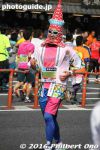
Tokyo Tower
|
|

View of Mt. Mikami from Omi-Fuji Karyoku Koen Park in spring.
|
|

View of Mt. Mikami-yama amid rice paddies in Yasu. Elevation 432 meters.
|
|

View of Mt. Mikami from Karasaki, across Lake Biwa.
|
|
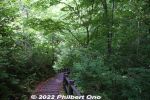
After seeing Ao-Ike blue pond, you can either backtrack and go back to Kyororo Gift Shop or go further and walk through the Japanese beech forest (highly recommended).
|
|
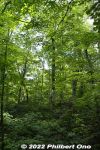
Experience forest bathing in this lush beech forest. Lots of ferns too.
|
|
|
|
|
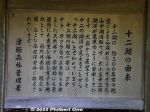
How Juniko Lakes were formed and named.
|
|
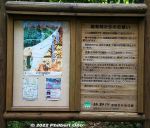
Forest rules: Do not stray away from the trail. Take your trash home, etc.
|
|

Walking trails and roads around Juniko Lakes.
|
|
|
|
|
|
|
|
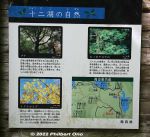
The flora around Juniko Lakes.
|
|
|
|
|
|
|
|
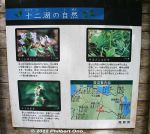
Flowers at Juniko Lakes.
|
|
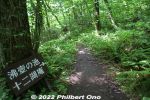
Way to Wakitsubo-no-Ike Pond 沸壺の池(沸壷の池), another blue pond.
|
|
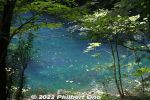
Wakitsubo-no-Ike Pond 沸壺の池(沸壷の池)is another blue pond along the beech forest trail.
|
|
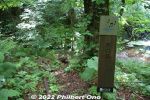
The Music of Water...
|
|
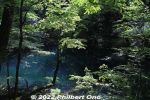
Wakitsubo-no-Ike Pond 沸壺の池(沸壷の池).
|
|
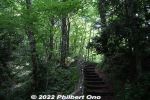
The beech forest trail eventually goes to the main road.
|
|

After passing through a bamboo grove, there is a clearing with the Tempo Gimin Monument.
|
|

At the foot of Mt. Mikami is Tempo Gimin Monument dedicated to the farmers who were tortured to death after the 1842 Tempo Ikki (天保一揆) uprising against the government's unfair land taxation surveys..
|
|

Gate to the Back Mountain Path. Be sure to close the gate after entering. I don't know how it would prevent monkeys from climbing over the low gate. Between Sept. 23 and Nov. 3 during mushroom season, 500 yen admission is charged for the Front/Back pa
|
|

Hiking up the Back Mountain Path. The trail actually goes mainly toward the side of the mountain rather than the back. The back of the mountain has a trail going down toward Kibogaoka Bunka Koen Park.
|
|

Two wooden signs pointed in opposite directions both say "To Mt. Mikami summit." Go right to continue on the easier Back Mountain Path. Or go left to get on the steeper Front Mountain Path. The large white sign says "Take home your trash.&q
|
|

Sacred tree. The bark from this tree is used for the roofing of the shrine. Do not scratch or damage it.
|
|

Steps
|
|

The trail is rocky and rooty, with lots of tree roots.
|
|

Sometimes log steps are provided.
|
|

Halfway point called Uchikoshi 打越. It's a small clearing and crossroads for multiple trails. Also a good place to harvest matsutake mushrooms during the fall (Sept. 23-Nov. 3).
|
|

Sign
|
|

This trail goes around the side of the mountain. Not recommended.
|
|

Trail to summit.
|
|

500 meters until the peak.
|
|

Roots
|
|

Chain railing is helpful.
|
|

Roots
|
|

Steel railing to grab.
|
|

Small torii and shrine.
|
|

No sign for this little shrine.
|
|

Kokegatani Valley. There's a small dip in the trail, going down and up again. This is a small valley near the peak. Visible as a small notch next to the peak. 苔が谷
|
|

Kokegatani
|
|

View from the dip. There should be a better view on the other side too, but too many trees block the view.
|
|

Yuba-no-Futokoro
|
|

The sign is almost totally unreadable.
|
|

Summit in sight.
|
|

Shrine and torii at the summit.
|
|

Shrine and torii at the summit.
|
|

A shrine with a view.
|
|

Gods here must be happy to see such grand views.
|
|

This is almost near the mountain's peak.
|
|

Sacred rock where the god lives.
|
|

Great view, but hazy when I was there. Ishibe is toward the left, and the shinkansen tracks toward the right.
|
|

Sign pointing to a lookout point, slightly below the shrine.
|
|

Going down to the lookout point.
|
|

Lookout point on Mt. Mikami in Yasu.
|
|

View from Mt. Mikami, Yasu. Ishibe is toward the left.
|
|
|

Looking toward Ritto
|
|

View from Mt. Mikami, Yasu.
|
|

On the right, Route 8 can be seen crossing Yasu River.
|
|

Route 8 crossing Yasu River
|
|

The path on the left leads to the mountain's peak.
|
|
|

To the peak.
|
|

Just beyond the tree is the peak.
|
|

Summit of Mt. Mikami. Only a small clearing with a bench. It was a great day for hiking. It is quite a popular mountain for climbers. Even for families with little kids. Didn't see any monkeys. No bears.
|
|

Sign at the summit.
|
|

"Take home your trash"
|
|

Going down from the summit.
|
|
|
|
|

Log steps
|
|

Large stone walls
|
|

Chain railing
|
|

Chain railing really helps.
|
|

Lots of ferns.
|
|

1.4 km to Karyoku Koen Park
|
|
|
|

Downward slope and trail. This trail is called the Karyoku Koen-gawa Tozando which starts from the Karyoku Koen flower park. 花緑公園側登山道
|
|

Tree trunk
|
|
|

850 meters to Karyoku Koen flower park.
|
|

Entrance/Exit to Karyoku Koen-gawa Tozando
|
|

Getting close to civilization.
|
|

Beware of snakes (mamushi). Never saw any. Never saw any monkeys either.
|
|
|
|
|

Prevent forest fires.
|
|

Minami-Chitose Station
|
|
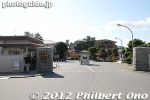
Entrance to the Naval Academy on Etajima.
|
|
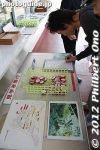
Reservations are not required, but you have to get there and sign up 5 min. before the 90-min. tour starts.
|
|

The Naval Academy conducts free guided tours of the school 3 or 4 times a day. The tour takes you around the campus and allows you to enter a few of the imposing buildings.
|
|

Map of the Naval Academy or Japanese Maritime Self Defense Force First Service School (海上自衛隊第1術科学校).
|
|
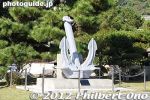
You cannot tour the Naval Academy on your own. You have to join the guided tour. There is a dress code: No miniskirts or provocative clothing by women.
|
|
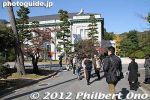
Two Naval Academy students served as our tour guide.
|
|
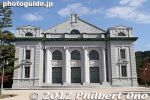
Ceremonial Hall. Built in 1917 and designed for holding ceremonies and moral education. One of the few buildings which we could enter. Etajima, Hiroshima.
|
|
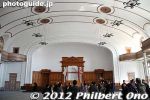
Inside the Ceremonial Hall. It can fit 2,000 people.
|
|
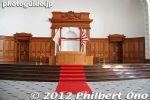
Stage inside the Ceremonial Hall.
|
|
|
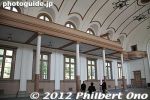
Ceremonial Hall
|
|
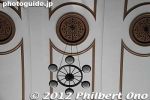
The lights look like a ship's wheel on the ceiling of the Ceremonial Hall.
|
|
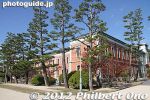
The academy's pine tree trunks grow straight up. They say that even the pine trees stand at attention at the school.
|
|
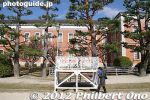
Stand for gatherings.
|
|
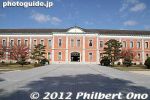
The academy's most distinctive building is this Students’ Hall dubbed the "Red Brick Building." We weren't allowed to go inside. Etajima, Hiroshima.
|
|
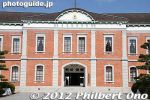
Built in 1893 and used for classrooms and living quarters for students. Today, it is part of the Officer Candidate School and used as classrooms and students' living quarters. Etajima, Hiroshima.
|
|
|
|
|
|
|
|
|
|
|
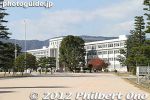
Students' Hall west wing. Built in 1938, it is used as the main students’ hall of the First Service School.
|
|

Students' Hall west wing. We weren't allowed to enter this building. The Academy also has female students, but after graduating they do not serve on navy ships. They work only on land.
|
|
|
|
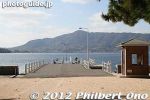
Front Pier. This is considered the school's front gate instead of the gate on land. Officer Candidate School graduates are sent off here by school staff and a military band and transferred to a training fleet anchored offshore in Etauchi inlet.
|
|
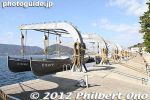
Training boats
|
|
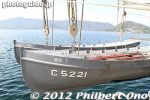
Training boats
|
|
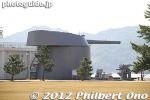
Battleship gun, life-size.
|
|
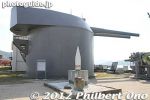
The Gun turret was a part of the main gunnery system of Battleship Mutsu and was transferred to Imperial Naval Academy for use as a study aide in 1935.
|
|
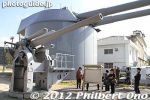
Gun turrets
|
|
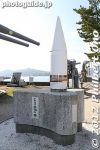
Projectile of a "Mutsu" class battleship.
|
|
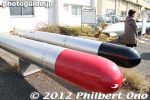
Torpedoes
|
|
|
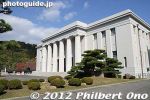
Naval History Museum on Etajima. Built in 1936, the museum is substantial with detailed exhibits tracing Japan's naval history (including the Pearl Harbor attack).
|
|
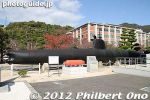
The Naval History Museum on Etajima has this outdoor display of one of the five midget submarines used in the Pearl Harbor attack.
|
|
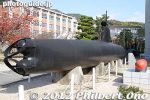
One of the five midget submarines used in the Pearl Harbor attack. On display at the Naval History Museum on Etajima island, Hiroshima.
|
|
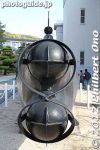
Torpedo bay of midget submarine used in Pearl Harbor attack.
|
|
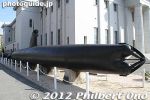
The midget sub displayed here was found in 1960 off Keehi Lagoon east of Pearl Harbor's entrance. The sub had been damaged by a depth charge attack and abandoned by its crew before it could fire its torpedoes.
|
|
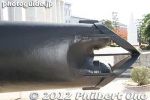
It was subsequently salvaged and restored for display at Etajima in 1962. The front part of the sub was severed, so the front part was reconstructed by a Kure shipbuilder for this display.
|
|
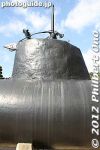
Midget sub's conning tower and periscope. The sub had only two crew members.
|
|
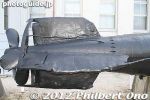
Midget sub's rudder and propeller.
|
|
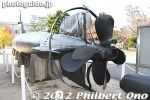
They eventually found all five subs (the fifth one was finally found in 2009) used at Pearl Harbor. Two of them are on display. One of them is here and the other is at the National Museum of the Pacific War in Fredericksburg, Texas.
|
|
|
|
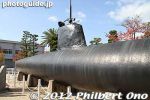
This midget sub was transported by boat from Pearl Harbor to Yokosuka (Kanagawa Pref.), then to Etajima in 1961.
|
|
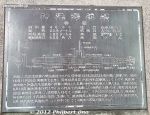
About this midget sub: Length: 23.9 meters, Weight: 46 tons, Inner diameter: 1.85 meter, Underwater speed: 19 knots (600 horsepower)
|
|
|
|
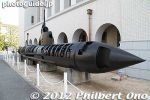
Behind the midget sub used in Pearl Harbor, another different type of midget sub is displayed.
|
|
|
|
|
|
|
|
|
|
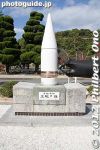
A projectile used by battleship Yamato during WWⅡ.
|
|
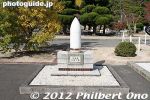
Projectile used in Japan-China War in 1894.
|
|
|
|
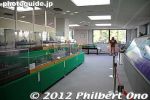
Last stop on the tour was the Etajima Club where there is a gift shop, restaurant, and this small museum on the 2nd floor.
|
|
|
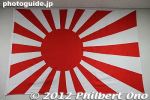
Japanese navy rising sun flag
|
|
| 1241 files on 5 page(s) |
1 |
 |
 |
|